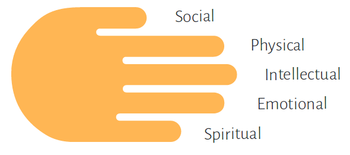Goal
The aim of this activity is to make transparent the expectations of participants and facilitators regarding content and cooperation. This allows the planning of content, goals, and methods to be need-focused.
Background: Five fields of needs
When planning and organizing a seminar, there are a host of aspects you consider as a facilitator. Imagine your participants’ needs are represented by a hand with five fingers. Each finger stands for a different type of need:
- 1. Social,
- 2. Physical,
- 3. Intellectual,
- 4. Emotional and
- 5. Spiritual.
Steps
1. Draw the Five fingers model ( see the in-depth explanation) on a pinboard and explain it to your participants.
2. Individual work: Participants are asked to note down their needs and expectations regarding the seminar on cards (1-3 keywords only on each card). [10 minutes]
3. Plenum: The cards are read aloud and stuck in the appropriate category on the pinboard. Participants are encouraged to ask questions if anything is unclear. [35 to 45 minutes]
4. The trainer sums up the participants’ expectations and comments, and adds the expectations of the trainers. [10 minutes]
5. Discussion and negotiation in the plenum. The aim is to reach a consensus in terms of seminar planning. If necessary, the program should be adjusted to address participants’ needs.
Experiences
There is a great deal of flexibility as to how much trainers position themselves at this early stage of the seminar with regard to different comments. When evaluating the seminar, trainers and participants should refer back to their expectations, to check to what extent they have been fulfilled.
Variation
Use an expectation box instead of a plenum: Participants drop their cards inside anonymously. Trainers can then evaluate them later during their planning sessions. Alternatively, small groups of participants can go through the cards and summarize the aspects described.



